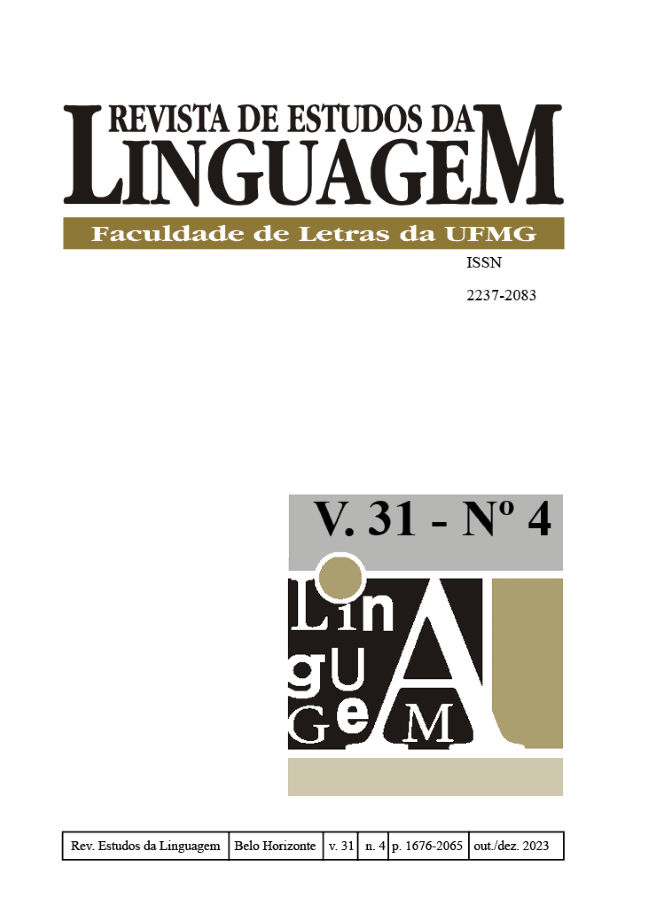Statues or Ballerinas?
Gaiarsa’s Contributions to an Embodied Multimodality in the Analysis of the Language of the Brazilians Anti-Democratic Demonstrators
DOI:
https://doi.org/10.17851/2237-2083.31.4.1723-1762Keywords:
body, habits, multimodality, communicational practices, proprioceptionAbstract
This article has a social semiotic and proprioceptive assumption. From the social semiotic point of view, people’s communication practice consists of resignifying languages, rather than creating them originally. At the same time, there is a maldistribution of language resources motivated by unequal power relations between people and social classes. Therefore, groups with scarce resources tend to reproduce communicational practices with the most available resources and which are shared by more people. The resignification and reproduction of resources make communicational practices become habits. From the proprioceptive point of view, habits come from attitudes formed by muscles, caused by power relations between people and the world. Therefore, this article presents as a thesis that a communicational practice of reframing, when becoming a habit, can itself become a language. This is a theoretical development article, based on bibliographical research, which seeks a synthesis between two theories. The objective is to propose a method to analyze the embodied multimodality. The article systematizes how communicational practices become habits and proposes a method for analyzing these practices. Based on this method, it presents an analysis of the language of anti-democratic demonstrators after the Brazilian elections in 2022. The result points to a language of denial of the body, the world and life, which emerges from the habits of resignification incorporated by the demonstrators, whose discourse is based on religious idealism, and militarism is a consequence of it. The conclusion is that the very choices of the demonstrators’ communicational practices are a language because it’s possible produce meaning.
Downloads
References
ANDRADE, S.; FREITAG, Raquel. Objetivos educacionais e avaliações em larga escala na trajetória da educação superior brasileira: Enem, Enade e a complexidade cognitiva na retenção do fluxo. Revista Brasileira de Estudos Pedagógicos, Brasilia, v. 102, n. 250, p. 177-204. 2021. DOI: https://doi.org/10.24109/2176-6681.rbep.102.i260.4264
BAGNO, M. A norma oculta: língua & poder na sociedade brasileira. São Paulo: Parábola. 2003a.
BATEMAN, J. A. Multimodality and Genre: a foundation for the systematic analysis of multimodal documents. London: Palgrave Macmillan, 2008.
BORGES, F. O jeito do corpo e o jeitinho brasileiro. 2005, 141 p. Tese (Doutorado em Comunicação Semiótica) – Faculdade de Comunicação. Pontifícia Universidade Católica de São Paulo, 2005.
BORGES, F. Uma abordagem corporal para corpos brasileiros. In: BORGES, F.C. (org.). O legado de Gaiarsa. São Paulo: Ágora, 2020. p. 151-164.
BORGES, F. Gaiarsa no século XXI: a psicoterapia do sentido. In: GAIARSA, J. A. A estátua e a bailarina. Ed. 3. São Paulo: Ágora, 2021.p.9-16.
BORTONI-RICARDO, S. Educação em língua materna: a sociolinguística na sala de aula. São Paulo: Parábola. 2004.
BOURDIEU, P. A economia das trocas simbólicas. São Paulo: Perspectiva, 2011.
DAMÁSIO, A. O erro de Descartes: emoção, razão e o cérebro humano. São Paulo: Cia das Letras, 2012.
FAUCONNIER, G.; TURNER, M. The way we think: conceptual blending and the mind’s Hidden complexities. New York: Basic Books, 2002.
FILIPE, F.; SILVA, D.; COSTA, A. Uma base comum na escola: análise do projeto educativo da Base Nacional Comum Curricular. ENSAIO, Rio de Janeiro, v. 29, n. 112, p. 783-803, 2021. DOI: https://doi.org/10.1590/S0104-40362021002902296
GAIARSA, J. A. A estátua e a bailarina. Ed. 3. São Paulo: Ágora, 2021 [1976].
GOODWIN, C. The co-operative, transformative organization of human action and knowledge, Journal Academy of Hospital Administration, Deli, v. 46, n.1, p. 08-23. 2012. DOI: http://dx.doi.org/10.1016/j.pragma.2012.09.003
GUALBERTO, C.; SANTOS, Z. Multimodalidade no contexto brasileiro: um estado de arte. DELTA, São Paulo, v.35, n.2, p. 02-30, 2019. DOI: https://doi.org/10.1590/1678-460X2019350205
HODGE, R.; KRESS, G. Social Semiotic. Cambridge: Polity Press, 1988.
JENKIS, H. Cultura da convergência. 2. ed. São Paulo: Aleph, 2009.
KRESS, G. Multimodality: A social semiotic approach to contemporary communication. London: Routledge, 2010.
KRESS, G.; Leeuwen, T. Critical Layout Analysis. Berghan Books, Oxford, v. 1, n. 1. p. 25-43, 1995.
KRESS, G.; Leeuwen, T. Multimodal discourse: The modes and media of contemporary communication. London: Arnold, 2001.
KRESS, G.; Leeuwen, T. Reading images: the grammar of visual design. 2. ed. London: Routledge, 2006 [ 1996].
KUSTERS, A.; SPOTTI, M.; SWANWICK, R.; TAPIO, E. Beyond languages, beyond modalities: transforming the study of semiotic repertoires. International Journal of Multilingualism, London, v.14, n.13, p. 219-232, 2017. DOI: https://doi.org/10.1080/14790718.2017.1321651
LEMOS, A.; LÉVY, P. O futuro da internet: em direção a uma ciberdemocracia planetária. São Paulo: Paulus, 2010.
MONTEIRO, J. Dez lições sobre Bourdieu. Petrópolis RJ: Vozes, 2018.
NAVAS, E. 2008. Remix: the bond of repetition and representation. Disponível em: https://museudememes.com.br/collection/nazare-confusa. Acesso em: 20 dez. 2020. s/p.
PRADO, P. Minha experiência com Gaiarsa, o senhor das estradas. In: BORGES, F.C. (org.). O legado de Gaiarsa. São Paulo: Ágora, 2020. p. 89-108.
SANTIAGO, S. Uma Literatura nos trópicos: ensaios sobre dependência cultural. Rio de Janeiro: Rocco, 2000.
SOUZA, J. Subcidadania brasileira: para entender o país além do jeitinho brasileiro. Rio de Janeiro: LeYa, 2018.




 Esta obra está licenciada com uma Licença
Esta obra está licenciada com uma Licença 